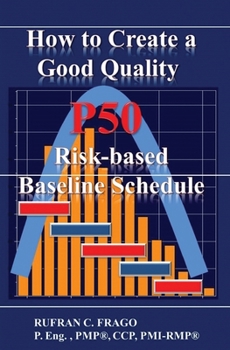How to Create a Good Quality P50 Risk-Based Baseline Schedule
New and upcoming project managers, leaders, planners, and schedulers would love to wrap their heads around this particular risk-based knowledge area and will enjoy reading this book. It is because one forgets that management tools only facilitate the route and provide quick indicators. The analysis resides mainly under the responsibility of a qualified risk-based project management practitioner like you are. There's no claim whatsoever that the tool will do or can do everything upon command.It is vital to know the process and understand the reference benchmarks employed in addition to being tool-savvy. The tool is a vehicle to get you where you need to be, quicker and more accurately. One must use the toolset to the "tool's right" for the project to succeed, to set it up correctly for speedy and correct turnarounds less those manual errors.I have observed that some will pretend to know the quantitative tool, which is detrimental to the company's processes. Some slice and dice things, although they have no clear idea what they're doing. It's time for all practitioners to sharpen the saw, know what is needed, why they are doing what they are doing, and finally, for the more qualified persons, perform what's rightfully their area, schedule quantitative expertise risk assessment.Intellectual deceit and incompetence are not acceptable. The two are a terrible combination. Ignorance is inexcusable because a professional has to dedicate himself to continuous education. I promised myself about three years ago that I will write a book on traditional SQRA. I have done it most shortly, and so everyone can understand.Through this book, you can learn at your own pace. Each Lesson uncovers a specific aspect of risk analysis. It discusses fundamental knowledge in the tool (OPRA) and related risk-based processes. I want the readers to confidently embark on schedule quantitative risk analysis without apprehension, with the absence of doubt and anxiety, because you executed the steps correctly. You are doing it right The traditional quantification technique is also called the three-point estimating method by many risk management practitioners. It looks at risk events and estimates uncertainties using three values of a given value, such as duration, quantity, and cost. The traditional method is applicable to cost risk analysis. It is excellent in capturing time-bound cost elements. The skills needed to perform SQRA have eluded many, even as they try to utilize the tool effectively. Relying on bits and pieces of information without understanding the quantitative process is a significant sticking point. I intend to address them, giving you, the readers, a full understanding of the subject.Isn't that what you want? Of course, you do
Format:Paperback
Language:English
ISBN:1508526036
ISBN13:9781508526032
Release Date:August 2017
Publisher:Createspace Independent Publishing Platform
Length:168 Pages
Weight:0.44 lbs.
Dimensions:0.4" x 5.3" x 8.0"
Customer Reviews
0 rating





